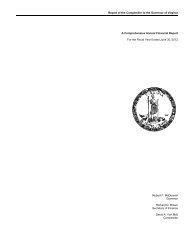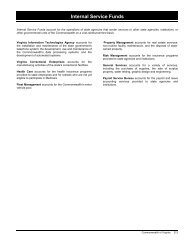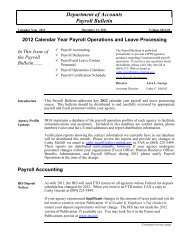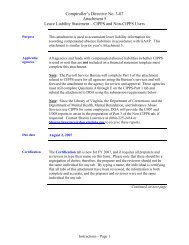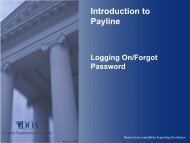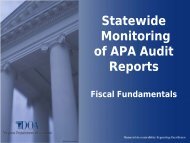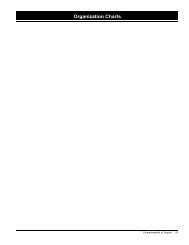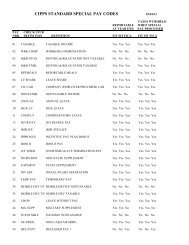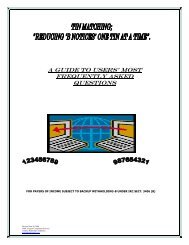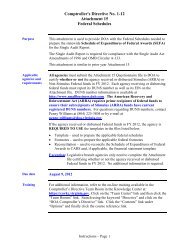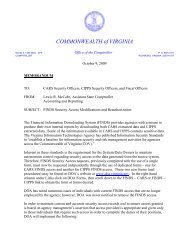Attachment HE-10 â TAB 3 Part 4 - Virginia Department of Accounts
Attachment HE-10 â TAB 3 Part 4 - Virginia Department of Accounts
Attachment HE-10 â TAB 3 Part 4 - Virginia Department of Accounts
You also want an ePaper? Increase the reach of your titles
YUMPU automatically turns print PDFs into web optimized ePapers that Google loves.
<strong>Attachment</strong> <strong>HE</strong>-<strong>10</strong> – <strong>TAB</strong> 3 <strong>Part</strong> 4: GASBS No. 42, Accounting and FinancialReporting for Impairment <strong>of</strong> Capital Assets and for Insurance RecoveriesPurposeOverview <strong>of</strong>requirementsThe purpose <strong>of</strong> GASBS No. 42 is to provide reporting guidance for thefollowing: impairment <strong>of</strong> capital assets (including intangible assets reportedas capital assets in accordance with GASBS No. 51) and most insurancerecoveries* (not just recoveries for impaired capital assets). (Note*: GASBSNo. 42 was issued prior to GASBS No. 49, Accounting and FinancialReporting for Pollution Remediation Obligations. Insurance recoveries forpollution remediation outlays must be reported in accordance with GASBSNo. 49.)Financial Statement Template Reporting:• Recognize Impairment Loss: Capital assets permanentlyimpaired during fiscal year 2012: The capital asset must be writtendown by the impairment loss amount. Any insurance recoveriesrecognized during the year for the impaired capital asset must benetted with the impairment loss. These losses should be reported asprogram expense-loss on sale/disposal/impairment <strong>of</strong> capital assets,special item, or extraordinary item.• Insurance Recoveries: For any insurance recoveries that are for prioryear capital asset impairments and/ or all other reasons except forpollution remediation activities (i.e. theft, embezzlement <strong>of</strong> cash, etc.),report these recoveries as program revenue-operating grants &contributions, program revenue – capital grants & contributions, or anextraordinary item.Footnote Disclosures:• Impairment Losses: The footnotes must include a generaldescription, the amount and the financial statement template line item.• Idle Permanently and/or Temporarily Impaired Capital Assets:The carrying amount <strong>of</strong> temporarily and/or permanently impairedcapital assets that are idle as <strong>of</strong> year-end must be disclosed.• All Insurance Recoveries: The footnotes must include the amountand financial statement template line item for all insurance recoveries(not just for impaired capital assets).Other Considerations:• For any capital assets that do not meet the impairment test, theremaining useful life and salvage value may need to be reevaluatedand changed on a prospective basis.This document is provided for informational purposes and is not authoritative.Refer to GASBS No. 42 and the Comprehensive Implementation Guide –Updated through June 30, 2011 for additional guidance.Page 1
<strong>Attachment</strong> <strong>HE</strong>-<strong>10</strong> – <strong>TAB</strong> 3 <strong>Part</strong> 4: GASBS No. 42, Accounting and FinancialReporting for Impairment <strong>of</strong> Capital Assets and for Insurance RecoveriesInstructions:<strong>Part</strong> 4.1This part is to identify potential impairments as follows:A) Possible Impairment <strong>of</strong> Capital Assets (including intangible assetsreported as a capital asset in accordance with GASBS No. 51): As <strong>of</strong>June 30, 2012, did the institution have an event* or change incircumstances* that may indicate an impairment <strong>of</strong> a capital asset asdescribed in GASBS No. 42? If yes, provide a description, month/year ittook place, the possible impaired capital assets, and then go to B. If no,go to <strong>Part</strong> 4.3.Note*: This must be a prominent event or circumstance that isconspicuous or known to the institution. It is expected to have beendiscussed by the board, management, or media. Common indicators <strong>of</strong>impairment include the following:• Physical damage (i.e. fire, flood)• Enactment or approval <strong>of</strong> laws/regulations or other changes inenvironmental factors• Technological development or evidence <strong>of</strong> obsolescence• Change in the manner or expected duration <strong>of</strong> a capital asset• Construction stoppages (i.e. lack <strong>of</strong> funding)B) Impairment Test: If yes to A, is the decline in service utility <strong>of</strong> thecapital asset significant and unexpected? If yes, go to C. If no, go to4.3.Note: If this test indicates an impairment has not occurred, the estimateduseful life and salvage value may need to be reevaluated and changed.This should be accounted for on a prospective basis.C) Permanent Impairment: If yes to A and B, is the impairmentconsidered permanent? If yes, go to D. If no, go to 4.2.Note: Generally, an impairment should be considered permanent;however, in some cases it may be considered temporary. If it isconsidered temporary, the capital asset should not be written down. SeeGASBS No. 42 for additional guidance.Continued on next pagePage 2
<strong>Attachment</strong> <strong>HE</strong>-<strong>10</strong> – <strong>TAB</strong> 3 <strong>Part</strong> 4: GASBS No. 42, Accounting and FinancialReporting for Impairment <strong>of</strong> Capital Assets and for Insurance RecoveriesInstructions:<strong>Part</strong> 4.1,continuedD) Financial Statement Template Reporting & Footnote Disclosure: Ifyes to A, B, and C, has the impairment loss and related insurancerecoveries (if applicable) been properly reported on the FST inaccordance with GASBS No. 42? If no, provide an explanation. If yes,provide the following: impairment loss, insurance recoveries recognizedin fiscal year 2012 included in the net impairment gain/(loss) calculation,and the FST line item that the net gain/(loss) on the impairment isreported on.Notes: For impaired capital assets that will continue to be used bythe institution, the impairment loss that should be written <strong>of</strong>f should bemeasured by one <strong>of</strong> the following methods: restoration cost approach,service units approach, or deflated depreciation replacement costapproach. For impaired capital assets that will no longer be used bythe institution or capital assets impaired from construction stoppage,they should be reported at the lower <strong>of</strong> carrying value or fair value.Loss on capital assets that became permanently impaired during fiscalyear 2012 must be reported on the financial statement template asprogram expenses–loss on sale/disposal/impairment <strong>of</strong> capital assets,extraordinary item, or special item. Use pr<strong>of</strong>essional judgment todetermine the appropriate FST line item.Also, per GASBS No. 42 paragraph 21, if insurance recoveries arereceived in the same year as the impairment loss, the impairment lossshould be reported net <strong>of</strong> the associated insurance recovery. Also, perGASBS No. 42 paragraph 17 - footnote 6, this guidance also applies toinsured impairments that result in an accounting gain.<strong>Part</strong> 4.2, IdleCapital Assets –Temporarily orPermanentlyImpairedAny permanently and/or temporarily impaired capital assets that are idle as <strong>of</strong>year-end must be disclosed. Provide the carrying amount <strong>of</strong> any permanentlyand/or temporarily impaired capital assets as <strong>of</strong> year-end.Page 3
<strong>Attachment</strong> <strong>HE</strong>-<strong>10</strong> – <strong>TAB</strong> 3 <strong>Part</strong> 4: GASBS No. 42, Accounting and FinancialReporting for Impairment <strong>of</strong> Capital Assets and for Insurance Recoveries<strong>Part</strong> 4.3, OtherInsuranceRecoveriesFor any insurance recoveries that are not reported in <strong>Part</strong> 4.1 D and do notrepresent insurance recoveries for pollution remediation obligations reportedon <strong>TAB</strong> 7 <strong>Part</strong>s 16d or 16e*, provide the amount and financial statementtemplate line item. Also, provide a description.Note: This includes current year insurance recoveries for capital assetsimpaired in prior years. It also includes all other insurance recoveries (i.e.recoveries for embezzlement <strong>of</strong> cash, theft) except those for pollutionremediation obligations. Insurance recoveries should be reported on thefinancial statement template as program revenue-operating grants &contributions, program revenue-capital grants & contributions, and / orextraordinary item. Use pr<strong>of</strong>essional judgment to determine the appropriateFST line item.Note * Insurance recoveries for pollution remediation obligations areaddressed on <strong>TAB</strong> 7 <strong>Part</strong> 16 regarding GASBS No. 49, Accounting andFinancial Reporting for Pollution Remediation Obligations.Page 4
<strong>Attachment</strong> <strong>HE</strong>-<strong>10</strong> – <strong>TAB</strong> 3 <strong>Part</strong> 4: GASBS No. 42, Accounting and FinancialReporting for Impairment <strong>of</strong> Capital Assets and for Insurance RecoveriesExamplesThe examples below are for a building that was impaired because <strong>of</strong> a fire. The followingexamples do not include restoration or replacement costs which should be reported as a separatetransaction from the impairment loss and associated insurance recovery.Impairment loss(prior year)Impairment loss(current year)InsuranceRecovery(current year)NetGain/(Loss)onimpairment(current year)Example 1 (200,000) 150,000 (50,000)Example 2 (200,000) 250,000 50,000Example 3 (200,000) 0 (200,000)Example 4 (200,000) 0 150,000Below are example FST entries for the current year from the above examplesExample 1:Cash 150,000Extraordinary item (net loss) (see Note A) 50,000Accumulated depreciation-buildings 200,000Example 2:Cash 250,000Extraordinary item (net gain) (see Note B) 50,000Accumulated depreciation-buildings 200,000Example 3:Extraordinary item (see Note A) 200,000Accumulated depreciation-buildings 200,000Example 4:Cash 150,000Extraordinary item (Note C) 150,000Note: For example 4, since the insurance recovery was not recognized in the same year as theimpairment loss, the insurance recovery is not netted with the impairment loss for the currentyear. Also, the $200,000 impairment loss should have been recorded in the prior year.Continued on next pagePage 5
<strong>Attachment</strong> <strong>HE</strong>-<strong>10</strong> – <strong>TAB</strong> 3 <strong>Part</strong> 4: GASBS No. 42, Accounting and FinancialReporting for Impairment <strong>of</strong> Capital Assets and for Insurance RecoveriesExamples, continuedNote A: Depending on the circumstances <strong>of</strong> the impairment, the other FST line items that thisloss could be reported on are as follows:• Expenses-Loss on Sale/Disposal/Impairment <strong>of</strong> Capital Assets• Special ItemNote B: Depending on the circumstances <strong>of</strong> the impairment, the other FST line items that thisgain could be reported on are as follows:• Gain on Sale/Disposal/Impairment <strong>of</strong> Capital Assets• Special ItemNote C: Depending on the circumstances <strong>of</strong> the impairment, the other FST line items that thisinsurance recovery could be reported on are as follows:• Program Revenue-Operating Grants & Contributions• Program Revenue-Capital Grants & ContributionsAs a reminder, per GASBS No. 34 the definitions <strong>of</strong> extraordinary items and special items are asfollows.• Extraordinary item: Transactions or events that are both unusual in nature and infrequentin occurrence.• Special item: Transactions or other events within the control <strong>of</strong> management that areeither unusual in nature or infrequent in occurrence.Continued on next pagePage 6
<strong>Attachment</strong> <strong>HE</strong>-<strong>10</strong> – <strong>TAB</strong> 3 <strong>Part</strong> 4: GASBS No. 42, Accounting and FinancialReporting for Impairment <strong>of</strong> Capital Assets and for Insurance RecoveriesExamples, continuedThe following provides guidance on how to report the example entries on the <strong>TAB</strong> 3:Example 1: Record on <strong>TAB</strong> 3 <strong>Part</strong> 4.1 D as follows:Financial Statement Template line item:Expenses-Loss on Sale/Disposal/Impairment <strong>of</strong> Capital AssetsSpecial ItemImpairment loss $(record as a negative)Insurance Recovery $included in the netimpairment gain/(loss)calculation (record as apositive)NetGain/(loss)onImpairmentGain on Sale/Disposal/Impairment <strong>of</strong> Capital AssetsExtraordinary Item -200,000 150,000 -50,000Example 2: Record on <strong>TAB</strong> 3 <strong>Part</strong> 4.1 D as follows:Financial Statement Template line item:Expenses-Loss on Sale/Disposal/Impairment <strong>of</strong> Capital AssetsSpecial ItemImpairment loss $(record as a negative)Insurance Recovery $included in the netimpairment gain/(loss)calculation (record as apositive)NetGain/(loss)onImpairmentGain on Sale/Disposal/Impairment <strong>of</strong> Capital AssetsExtraordinary Item -200,000 250,000 50,000Example 3: Record on <strong>TAB</strong> 3 <strong>Part</strong> 4.1D as follows:Financial Statement Template line item:Impairment loss $(record as a negative)Insurance Recovery $included in the netimpairment gain/(loss)calculation (record as apositive)NetGain/(loss)onImpairmentExpenses-Loss on Sale/Disposal/Impairment <strong>of</strong> Capital AssetsSpecial ItemGain on Sale/Disposal/Impairment <strong>of</strong> Capital AssetsExample 4: Record on <strong>TAB</strong> 3 <strong>Part</strong> 4.3*Extraordinary Item -200,000 -200,000Financial Statement Template line item Other Insurance Recoveries $Program Revenue - Operating Grants and ContributionsProgram Revenue - Capital Grants and ContributionsExtraordinary Item 150,000Note*: Since the impairment took place in the prior year and the insurance recovery took placein the current year, no amount would be reported on the <strong>TAB</strong> 3 <strong>Part</strong> 4.1D and only the insurancerecovery would be reported on the <strong>TAB</strong> 3 <strong>Part</strong> 4.3.Page 7
This Page Intentionally Left Blank




